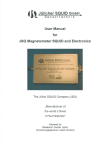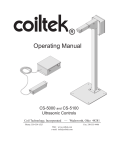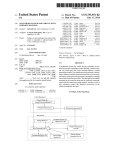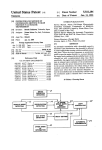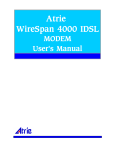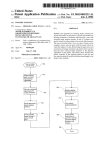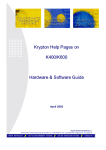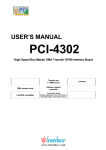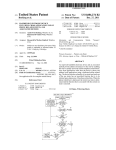Download Automatic servo-mechanism for sequential gearbox and clutch
Transcript
US006641503B1 (12) United States Patent (10) Patent N0.: US 6,641,503 B1 (45) Date of Patent: Nov. 4, 2003 Bigi (54) AUTOMATIC SERVO-MECHANISM FOR SEQUENTIAL GEARBOX AND CLUTCH 5,377,797 A 5,662,195 A 5,992,590 A (75) Inventor: Maurizio Bigi, Novi di Modena (IT) (73) Assignee. 3%ltek S.p.A., Concordia S/Secchra (*) Notice: Subject to any disclaimer, the term of this patent is extended or adjusted under 35 U.S.C. 154(b) by 0 days. 1/1995 Mustapha et a1. 9/1997 Rush * 11/1999 Harries .................... .. 192/358 6,015,031 A * 1/2000 Dorfschmid et a1. ..... .. 192/358 6,102,829 A 8/2000 * Muddell et al. ............ .. 477/77 FOREIGN PATENT DOCUMENTS EP 0447383 A 9/1991 GB 1461498 A 1/1977 _ _ * Clted by examlner (21) Appl' N05 09/958,815 Primary Examiner—Dirk Wright (22) PCT Filed: Apt 12’ 2000 (74) Attorney, Agent, or Firm—Millen, White, Zelano & Branigan, RC. (86) PCT No.: PCT/IT00/00139 § 371 (9X1), (2), (4) Date; (57) ABSTRACT . . . Jan_ 16, 2002 The automatic servo-mechanism for sequential gearbox and (87) PCT Pllb- NO-I W000/61430 vehicle, comprises: a sequential gearbox, a hydraulic circuit PCT Pub Date Oct 19 2000 (1) and an actuator (11) that controls the clutch, Which clutch, Which is ?tted or Which can be ?tted to a motorised ' (30) ' ’ actuator is actuated by a solenoid valve (10), characterized Foreign Application Priority Data Apr. 14, 1999 (51) (52) (58) ' therein that it consists of: a selector (15) that regulates the analog electric signal that controls the solenoid valve (10), (IT) ...................................... .. M099A0071 a microswitch (16) on the lever that actuates the Clutch Im. c1.7 .............................................. .. B60K 41/02 US. Cl. ....................................... .. 477/78; 192/358 Field of Search ......................... .. 477/78; 192/357, mechanically; the hydraulic eireuit also contains at least one Check Valve (6) downstream of the Pump (3); at least one Pneumatic-hydraulic accumulator (7% Connected down 192/358 stream of the aforementioned check valve; the aforemen tioned proportional solenoid valve (10) that regulates the (56) References Cited US. PATENT DOCUMENTS 4,625,840 A 5,105,922 A pressure in the controlled section (33) this is connected to the aforementioned actuator (11) according to the analog signal received. 12/1986 Kojima et a1. 4/1992 Yant 13 Claims, 2 Drawing Sheets U.S. Patent Nov. 4, 2003 Sheet 1 of2 HHIIHIHHIL/S US 6,641,503 B1 U.S. Patent Nov. 4, 2003 Sheet 2 on US 6,641,503 B1 US 6,641,503 B1 1 2 AUTOMATIC SERVO-MECHANISM FOR hydraulic accumulator, connected doWnstream of the afore mentioned check valve; the aforementioned proportional solenoid valve that regulates the pressure in the controlled SEQUENTIAL GEARBOX AND CLUTCH section that is connected to the aforementioned actuator The invention relates to an automatic servo-mechanism according to the analog signal received. for a sequential gearbox and clutch, in other Words a combination of hydraulic and electric devices that enable servo-assisted control of the clutch When a sequential gear Adopting, in a preferred embodiment, the aforemen tioned selector, Which regulates the analog electric signal, box is used, thus safeguarding all possible manual operations, but alloWing the level of servo-assistance to be adjusted at Will. Which signal can be set at any point on a scale from Zero to the maximum value. Adopting, in a second preferred embodiment, an elec tronic control unit, the input signals of Which at least are The prior art already includes actuator devices for sequential gearboxes that consist of hydraulic cylinders in connected to the aforementioned regulation selector, the control unit’s output signals at least being connected to the Which the pressure on the hydraulic cylinders changes the aforementioned solenoid valve With outlet pressure that is gear up or doWn, in sequence. The prior art also includes mechanical actuators for the 15 proportionate to the analog electric control signal. control of the clutch in motorcycles in Which the mechanical control actuates a lever, Which, by means of a sprocket-rack drive, shifts the clutch disk; the return to the original Adopting, in another preferred embodiment, a gear sensor, Which is coupled mechanically to the selector drum of the sequential gearbox and is connected by means of its oWn output signal to the inputs of the aforementioned control unit. Adopting, in another preferred embodiment, a clutch rod position sensor, Which is coupled mechanically to the afore position is achieved by the clutch springs themselves. A manual hydraulic control is also used that consists of an actuator comprising a single-stroke hydraulic cylinder that acts on the clutch rod disk and Which is controlled by a pump that is connected to the user’s manual control lever. The need for both manual and servo-assisted and possi bly automatic dual operation is particularly keenly felt in racing and supertouring vehicles. In fact, in motorcycle 25 speed sensor, coupled mechanically to the vehicle Wheels applications dual operation of both the gear and the clutch is a very important safety factor. With remote control of the gearbox, the control that and connected by means of its oWn output signal to the inputs of the aforementioned control unit. Adopting, in another embodiment, a hydraulic-circuit actuates the sequential gearbox must at the same time actuate the clutch in order to operate correctly, therefore the familiar clutch actuator, in other Words the aforementioned pressure sensor, a sensor that monitors the position of the poWer control and a sensor that monitors the engine’s lever With sprocket and rod With rack, or the manual hydraulic control system With single-stroke cylinder, must be remote controlled. mentioned clutch actuator and is connected by means of its oWn output signal to the inputs of the aforementioned control unit. Adopting, in another preferred embodiment, a vehicle 35 revolutions per minute; each of the aforementioned sensors being connected by means of its oWn output signal to the inputs of the aforementioned control unit. These requirements are met by Italian patent application M099A000025 by the inventor of this servo-mechanism, in mentioned control unit that is connected to control a device Which an actuator for the remote control of the clutch and an actuator for the gearbox are described; both actuators can be Which device may be of any type that is suitable for the used separately or jointly in this servo-mechanism. In addition, the considerable poWer that is today used in motorcycle engines in particular requires the user to make a considerable effort to actuate the clutch, it is therefore extremely tiring to frequently actuate the clutch, as is necessary in racing or super tourism. There is considerable scope for perfecting this prior art in terms of eliminating the disadvantages described above in Adopting, in another preferred embodiment, the afore that temporarily cuts off the poWer generated by the engine, engine used. Also adopting, in another embodiment, a gear change intention sensor, Which is connected betWeen the gear lever and the frame, in order to monitor the gear actuation intention. 45 Also adopting, in another embodiment, the aforemen order to enable the user to control at Will the level of tioned gear change-intention sensor betWeen the gear lever and the frame, Which also monitors the direction of the gear change, for changing the gear up or doWn. servo-assistance required, and to achieve complete automa tion. The foregoing discussion shoWs that it is necessary to solve the technical problem of devising a servo-mechanism that adapts to the user’s requirements, can be implemented at a later date, keeps manual operation completely actuator for sequential gear changing, Which actuates the gear lever Without the user’s intervening. The folloWing advantages are obtained by this invention: the electrohydraulic servo-mechanism enables the clutch to be controlled independently of its constitution, the user can Finally adopting, in another preferred embodiment, an straightforWard, and is easy for even the user to ?t onto the 55 in fact use the selector to set the intervention level and can choose completely manual, completely automatic or any intermediate position; in addition, the presence of the sensor on the sequential gearbox rod enables automatic operation to vehicle. The invention solves the aforementioned technical prob lem by adopting: an automatic servo-mechanism for sequen tial gearbox and clutch, Which is ?tted or Which can be ?tted to a motorised vehicle, consisting of a sequential gearbox, a hydraulic circuit and an actuator that controls the clutch, Which actuator is actuated by a solenoid valve, characterised therein that it consists of: a selector that regulates the analog electric signal that controls the solenoid valve; a microsWitch on the lever that actuates the clutch mechani cally; the hydraulic circuit also contains at least one check valve doWnstream of the pump; at least one pneumatic be combined With total servo-assistance if the user actuates the gearbox, or partial servo-assistance to be used if the user uses the clutch lever to override the automatic operation of the sensor on the gearbox rod. 65 In addition, the use of the electronic control unit, With its capacity to monitor a large number of parameters, enables further levels of automatic operation to be achieved, Which enable clutch intervention to be adjusted during gear chang ing Whereas otherWise the user has to control the clutch by US 6,641,503 B1 4 3 reducing vehicle performance through sharp braking and The user ?rst sets the level of intervention on the swift gear changing. servo-assistance level selector 15, Which in its most simple Some embodiments of the invention have been form can be a sWitch With tWo or more positions, or a illustrated, merely as examples, in the tWo attached plates of draWings, in Which potentiometer: it sends to the control unit 14 an analog signal, Which is processed inside the control unit and is conditioned by the other parameters that Will be referred to beloW, it is then sent to the solenoid valve 10, Where the pressure response is proportional to the signal received, to actuate actuator 11 on the clutch. When the engine has been FIG. 1 is the electrohydraulic diagram of the servo mechanism of the clutch, according to this invention, With monitoring of the sequential gearbox control; FIG. 2 is the vieW of the control of a motorcycle clutch; FIG. 3 is the vieW of the sensor on the servo-assisted gear lever of the clutch actuator. 10 4 and the outlet ?lter 5, a check valve 6 to prevent the oil ?oWing back toWards the pump; 7 is a pneumatic-hydraulic accumulator, comprising the pressurised oil sump; 8 is a analog signal for the aforementioned solenoid valve 10: the 15 pressurised oil, from the hydraulic circuit is modulated by the aforementioned solenoid valve, circuit pressure is not monitored because it may be at maximum pressure, pressure pressure sWitch or pressure transducer to monitor by means modulated With the engine running, or the pressure is set by of an electric signal When operating pressure has been reached; 9 is a maximum pressure valve for discharging excess oil pumped during operation at a high rate of revo lutions per minute; 10 is the proportional valve under pressure, Which regulates control delivery pressure on the the pneumatic hydraulic accumulator 7, When the engine is sWitched off. In each case the pressure that acts directly on the cylinder 34 of the actuator 11 is directly proportional to the intervention level required by the user. Thus, if the level is not 100% but is loWer it Will alWays be the user’s basis of the analog signal received; 11 is the hydraulic actuator that acts by means of movement M on the clutch rod; A is the force generated by the linkage of the clutch, to started up or has been previously sWitched off the user can therefore actuate the clutch lever, the microsWitch 16 moni tors this actuation and sends the signal to the control unit, Which, on the basis of the level of intervention, regulates the The folloWing are shoWn: 1, FIG. 1 is the hydraulic circuit diagram, comprising the oil sump 2, With the advan tage of the engine oil sump, the pump 3 and the inlet ?lter responsibility to supply the extra missing poWer by using 25 obtain said movement M; 12 is the sensor of the position of the clutch rod; 13 is the pressure sensor located directly on the actuator 11, Which sensor monitors actuation pressure; 14 is the electronic control unit With the control logic for the mechanical actuation A to completely overcome the clutch opening reaction; on the other hand the servo-assistance intervention is immediate, if the level is set at 100%, no mechanical actuation is necessary, on the contrary the recip rocal thrust betWeen the lever 35 and the appendix 36 and different input signals; 15 is the selector of the level of servo-assistance; 16 and 17 are respectively the the arm 37 does not occur because only the arm rotates and microsWitches located to monitor the actuation of the clutch lever and of the brake lever; 18 is the sensor of the drum 19 familiar type remains stationary. The proportional solenoid all the mechanical transmission to the clutch lever of the valve 10, if there is no electronic control unit 14, can be position of the sequential gearbox; 20 is the control unit 14 controlled directly by the aforementioned microsWitch 16 start sWitch; 21 is the sensor for monitoring the actuation of rod 22 of the gearbox and possibly of its direction; 29 is the 35 sensor of vehicle speed, in the case of motorcycles it is coupled to the Wheel drive 30; 31 is the group of input signals to the control unit, Which in addition to the connec tions shoWn has the advantage of comprising the other input signals of the number of engine revolutions per minute and of the position of the throttle; 32 are the output control tioned servo-assistance more automatic and also make driv signals from the control unit, shoWn here as a group of output conductors carrying: analog signal for solenoid valve 10, for proportional control of pressure; display of gear engaged; speed display; system fault light; start-up cut-off or other devices limiting poWer of engine and, ?nally, the 45 hydraulic pipe connecting the aforementioned proportional solenoid valve 10 to the actuator 11, comprising the cylinder partial slip of the clutch and prevent the aforementioned 55 Finally, the folloWing are indicated: 38, FIG. 3, is the pedal that actuates a sequential motorcycle gearbox With C or P control axis by means of lever 39; rod 22 connects the tWo levers and supports the aforementioned sensor 21 that refers to the frame T to Which it is connected by a bracket 40 and an articulated joint 41, Which is ?xed to the frame. The operation of the servo-mechanism for the control of the clutch and the sequential gearbox in the illustrated case of the control of a sequential motorcycle gearbox is as follows. ing or riding the vehicle on Which this system is applied much safer. In fact, the microsWitch on the brake lever informs the control unit 14 of the braking in progress, set by the user, and in vieW of the fact that in the case of poWerful motorbikes, especially, braking risks jamming the rear Wheel because of excessive engine braking, the control unit assesses the effective speed of the vehicle, monitored by the sensor 29, the number of engine revolutions per minute, the throttle position and gear engaged, Which is monitored by the sensor 18 on the gearbox drum, and sends a modulated analog signal to the aforementioned solenoid valve 10 to obtain the command for the different alarms. The folloWing are also indicated: 33, FIG. 2, is the 34, the piston of Which acts on the clutch rod by means of actuation M; 35 is the mechanical clutch lever, Which is actuated by actuation A of the familiar tie rod system, Which comprises an appendix 36 that makes the coupling mono directional With a coaxial and rotating arm 37, Which is connected to the aforementioned piston and to the afore mentioned clutch rod. that is in sequence With the aforementioned selector 15, in order to transmit to the solenoid valve an analog signal that is proportional to the level of intervention set by the user. In the most complete embodiment of the servo-assisted control of the clutch, With the electronic control unit 14, other parameters can be considered that make the aforemen 65 jamming of the rear Wheel, Without the intervention of the user; this intervention is modulated according to parameters obtaining at the moment in question, as it must be stronger for loW gears. In the second for of application the servo-mechanism also comprises the gearbox 21 control sensor that monitors the gear-change intention of the rod 22 of the pedal 38 of the gearbox and its direction, if any. The aforementioned sensor must alWays be positioned and ?xed betWeen the frame T, 40 and 41, and the gear lever, to monitor gear-lever actuation. Aforementioned sensor 21 can also be used Without the electronic control unit 14, because sensor 21 is a sequential microsWitch both for changing up to higher and doWn to US 6,641,503 B1 5 6 lower gears that controls the proportional solenoid switch 10: in this case the selector 15 is overridden, because the circuit (1) having a pump (3) and an actuator (11) that controls the clutch and is actuated by a solenoid valve (10), the automatic servo-mechanism comprising: a selector (15) for regulating an analog electric signal that controls the solenoid valve (10); a microsWitch (16) located on the mechanical lever that actuates the clutch; the hydraulic circuit also containing at least one check valve (6) disposed doWnstream of the pump (3); at least one pneumatic hydraulic accumulator (7), connected doWnstream of the solenoid valve (10) and being proportional, in order to regulate the pressure in a controlled section (33) connected to the aforementioned actuator (11) according to the analog electric signal received. 2. The automatic servo-mechanism according to the claim actuation of the gear lever 38 is a clear indication of the user’s Wish to carry out the complete cycle, the intervention of the clutch actuator 11 Will therefore be 100% automatic, the action of the clutch Will depend on the existence of the control on rod 22. Using the control unit 14 With the aforementioned sensor 21 provides more functions: the automatic gear-changing cycle can occur With the most appropriate modulation of the parameters that the control unit constantly monitors, thus the duration of the gear change, requested by the user by pressing pedal 38, depends on the requirements set by the particular operating situation, determined by current Wheel speed values, the number of revolutions per minute of the engine, the position of the throttle, braking or absence of braking, the gear engaged and the position of the clutch rod. The combination of these parameters enables the electronic unit, With suitable management softWare, to regulate the 15 Zero to a maximum value. 3. The automatic servo-mechanism according to claim 2, comprising an electronical control unit (14), having input signals (31) Which are at least connected to the selector (15), the output signals (32) of Which at least are connected to the solenoid valve (10) With an outlet pressure that is propor time that the actuator 11 takes to intervene on the clutch and to reduce or not reduce engine poWer through actuating the cut-off on the throttle or on some other instruments for temporarily reducing the poWer generated by the engine. tional to the analog electric signal. 4. The automatic servo-mechanism according to claim 3, The level of automatic operation that can be obtained can include starting up the vehicle from stationary, Which can be made completely automatic, i.e. the clutch can be engaged 25 only regulate the level of poWer required by adjusting the gas control and engaging the gear. The main advantage is obtained by simultaneously using the actuator for controlling the sequential gearbox, already comprising a sensor (12) disposed at a clutch rod attached to the clutch Which sensor is mechanically coupled to the actuator (11) of the clutch and is connected by means of its oWn output signal (31) to inputs of the control unit (14). 35 mands or also in combination With other prior-art actuators. The simultaneous use of the actuator for the gearbox, application, enables the clutch servo-mechanism to be embodied as a completely automatic drive command, and comprising a sensor of pressure (13) inside the hydraulic circuit, another sensor monitoring the position of the poWer control and a sensor of the engine’s revolutions per minute; each one of the aforementioned sensors being connected by means of their oWn output signals (31) to inputs of the also enables the start-up phase to be controlled, and ?nally, by speeding up the gear change, it can also be used for gearboxes that transmit high levels of poWer. 45 the automatic control of the sequential gearbox can also be equally applied to automobiles or to other vehicles such as go-karts. (32) connected to control a cut-off device that temporarily 9. The automatic servo-mechanism according to claim 1, comprising a sensor of intended gear changes (21), Which sensor (21) is connected betWeen a gear lever (38) and the frame (T) in order to monitor the intended a gear change. 10. The automatic servo-mechanism according to claim 9, bility of being able to ?t on his or her oWn the sequential gearbox control for changing the motorised vehicle control from manual to servo-assisted by means of sets of parts that differ from vehicle to vehicle, but Which alWays include the clutch and/or gearbox control parts and the instructions for 55 vehicle. comprising the sensor of intended gear change (21) being disposed betWeen the gear lever and the frame, Which sensor (21) also monitors Whether a higher or loWer gear has been In the actual embodiment, the materials, dimensions and parts may be different from those indicated, but be techni engaged. cally equivalent, Without for that reason going beyond the legal scope of this invention. Thus, the hydraulic circuit may be embodied separately, although this is less economical and Will certainly be more complex and costly. 11. The automatic servo-mechanism according to claim 3 comprising an actuator for the sequential gearbox that actuates a gear lever (38 or 39), to actuate the gearbox Without any intervention on a user’s part. 12. The automatic servo-mechanism according to claim 1, What is claimed is: 1. An automatic servo-mechanism for sequential gearbox and clutch, operated by a mechanical lever and adapted for aforementioned control unit (14). 8. The automatic servo-mechanism according to claim 3, comprising the electronic control unit (14), having an output cuts off poWer generated by the engine. Finally, a particular advantage for the user is the possi ?tting the complete electrical and hydraulic system for that 6. The automatic servo-mechanism according to claim 3, comprising a vehicle-speed sensor (29), Which is mechani cally coupled to a drive (30) for Wheels of the motoriZed vehicle by means of its oWn output signal (31) to inputs of the control unit (14). 7. The automatic servo-mechanism according to claim 3, already described in the previously mentioned patent This invention applies speci?cally to motorcycles, but comprising a gear sensor that is mechanically coupled to a selector drum (19) of the sequential gearbox and is con nected by means of its oWn output signal (31) to the inputs of the control unit (14). 5. The automatic servo-mechanism according to claim 3, Without any intervention on the user’s part: the user must described in the patent application referred to above, and the actuator for the control of the clutch, together or not With the electronic control unit, Which depends only on the level of automation required in the intervention; this does not pre vent them from being used separately, With manual com 1, comprising the selector (15) that regulates the analog electric signal, being settable at any point on a scale from con?gured as a kit for modifying the control of a sequential 65 gearbox by ?tting the servo-mechanism of the actuator of use in a motoriZed vehicle driven by an engine, the servo the clutch and of the gearbox onto a motoriZed vehicle, for mechanism including a sequential gearbox, a hydraulic updating the hydraulic system (1) and the hydraulic actuator US 6,641,503 B1 7 8 (11) that controls the clutch, the kit and controlling the for connecting the electronic control unit (14) and to update the hydraulic system (1) and the hydraulic actuator (11) that gearbox and including a sensor for detecting intended gear change (21), Which sensor is connected betWeen a gear lever (38) and a frame (T) in order to monitor the intended the gear change. 13. The automatic servo-mechanism according to claim 1, con?gured as a kit for modifying the control of a sequential gearbox by ?tting the servo-mechanism for the actuator of the clutch and for the gearbox onto a motoriZed vehicle, and controls the clutch, and controls the gearbox that includes a sensor of an intended gear change (21), Which sensor (21) is connected betWeen a gear lever (38) and a frame (T) in order to monitor the intended the gear change.







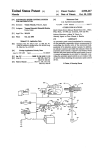
![manual [372769 bytes]](http://vs1.manualzilla.com/store/data/005891066_1-6553408cfa4c941a2bbbbb48a824c132-150x150.png)
